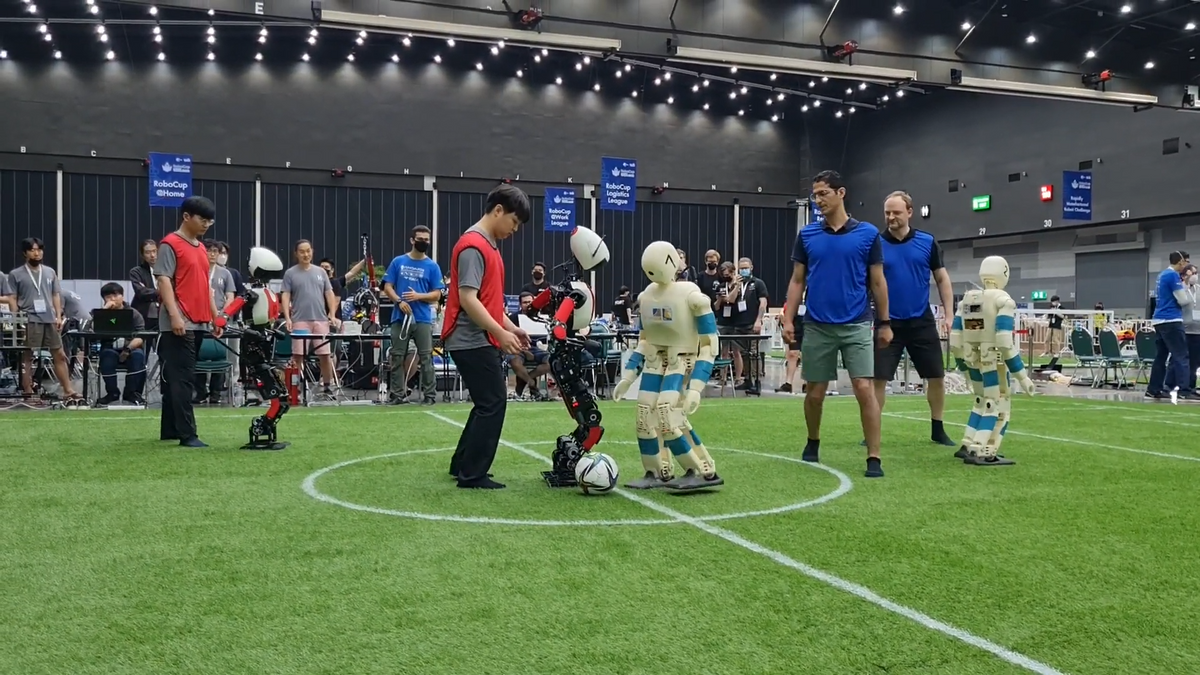Video Friday is your weekly selection of awesome robotics videos, collected by your friends at IEEE Spectrum robotics. We also post a weekly calendar of upcoming robotics events for the next few months. Please send us your events for inclusion.
CoRL 2022: 14–18 December 2022, AUCKLAND, NEW ZEALAND
ICRA 2023: 29 May–2 June 2023, LONDON
Enjoy today’s videos!
The videos show scenes from the RoboCup 2022 Humanoid AdultSize competition in Bangkok, Thailand. The robots of Team NimbRo of the University of Bonn, Germany, won the main soccer tournament, the Drop-In tournament, and the Technical Challenges. Consequently, NimbRo came in first in the overall Best-Humanoid ranking.
[ NimbRo ]
Have you ever seen a robot dancing? One of the highlights of the 20th anniversary event of Robotnik was the choreography between the professional ballet dancer Sherezade Soriano and the mobile manipulator robot RB-KAIROS+.
[ Robotnik ]
This video celebrates the 10-year anniversary of the University of Zurich’s Robotics and Perception Group, led by Prof. Davide Scaramuzza. The lab was founded in 2012. More than 300 people worked in our lab as BSc, MSc, and Ph.D. students, postdocs, and visiting researchers. We thank all of them for contributing to our research. The lab made important contributions to autonomous, agile, vision-based navigation of micro aerial vehicles and event cameras for mobile robotics and computer vision.
Ten years, so much accomplished, and they’re just getting started!
[ UZH RPG ]
Printed fiducial markers are inexpensive, easy to deploy, robust, and deservedly popular. However, their data payload is also static, unable to express any state beyond being present. Our “DynaTags” are simple mechanisms constructed from paper that express multiple payloads, allowing practitioners and researchers to create new and compelling physical-digital experiences.
[ CMU FIG ]
CNN’s “Tech for Good” hears from Marko Bjelonic, from ETH Zürich’s Robotic Systems Lab and founder of the Swiss Mile robot, who believes automated machines are the key to automating our cities. His four-legged-and-wheeled robot is able to change shape within seconds, overcome steps, and navigate between indoor and outdoor environments. It’s hoped that the bot, which can travel up to 20 kilometers an hour and carry 50 kilograms, has the potential to serve as a member of search-and-rescue teams in the future.
[ Swiss-Mile ]
Thanks, Marko!
Be the tiny DIY robot cat you’ve always wanted to be!
All of this is open source, and you can get it running on your own Nybble (which makes a great holiday gift!) at the link below.
[ Petoi ]
Thanks, Rz!
In his dissertation “Autonomous Operation of a Reconfigurable Multi-Robot System for Planetary Space Missions,” Thomas Röhr deals with heterogeneous robot teams whose individual agents can also join to form more capable agents due to their modular structure. This video highlights an experiment that shows the feasibility and the potential of the autonomous use of reconfigurable systems for planetary-exploration missions. The experiments feature the autonomous execution of an action sequence for multirobot cooperation for soil sampling and handover of a payload containing the soil sample.
[ DFKI ]
Thanks, Thomas!
Haru has had a busy year!
[ Haru Fest ]
Thanks, Randy!
This is really pretty impressive for remote operation, but it’s hard to tell how much of what we see is the capability of the system, and how much is the skill and experience of the operator.
[ Sanctuary AI ]
Cargo drones are designed to carry payloads with a predefined shape, size, and/or mass. This lack of flexibility requires a fleet of diverse drones tailored to specific cargo dimensions. Here we propose a new reconfigurable drone based on a modular design that adapts to different cargo shapes, sizes, and masses.
[ Paper ]
Building tiny giant robots requires lots of little fixtures, and I’m here for it.
[ Gundam Factory ]
The load-bearing assessment that’s part of this research is particularly cool.
[ DFKI ]
The Utah Bionic Leg, developed by University of Utah mechanical-engineering associate professor Tommaso Lenzi and his team in the HGN Lab, is a motorized prosthetic for lower-limb amputees. The leg uses motors, processors, and advanced artificial intelligence that all work together to give amputees more power to walk, stand up, sit down, and ascend and descend stairs and ramps.
[ Utah Engineering ]
PLEN is all ready for the World Cup.
[ PLEN ]
The Misty platform supports multiple programming languages, including Blockly and Python, making it the perfect programming and robotics learning tool for students of all ages.
[ Misty ]
Sarcos Technology and Robotics Corp. designs, develops, and manufactures a broad range of advanced mobile robotic systems that redefine human possibilities and are designed to enable the safest, most productive workforce in the world. Sarcos robotic systems operate in challenging, unstructured, industrial environments and include teleoperated robotic systems, a powered robotic exoskeleton, and software solutions that enable task autonomy.
[ Sarcos ]
Teaser for the NCCR Robotics documentary coming in late 2022.
[ NCCR Robotics ]
A robotic feeding system must be able to acquire a variety of foods. We propose a general bimanual scooping primitive and an adaptive stabilization strategy that enables successful acquisition of a diverse set of food geometries and physical properties. Our approach, CARBS: Coordinated Acquisition with Reactive Bimanual Scooping, learns to stabilize without impeding task progress by identifying high-risk foods and robustly scooping them using closed-loop visual feedback.
[ Paper ]
Join Jonathan Gammell and our guest speaker Larry Matthies, NASA JPL, discussing In situ mobility for planetary exploration in the third seminar of our Anniversary Series.
[ ORI ]
Evan Ackerman is a senior editor at IEEE Spectrum. Since 2007, he has written over 6,000 articles on robotics and technology. He has a degree in Martian geology and is excellent at playing bagpipes.



